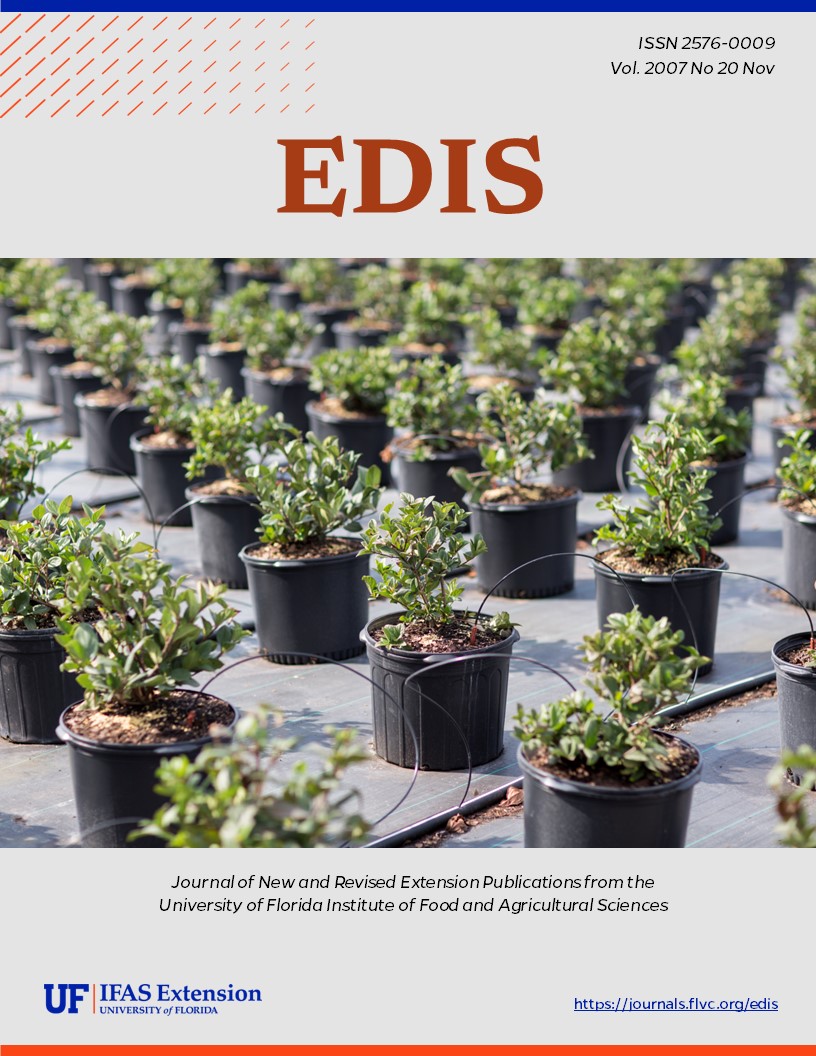Abstract
EENY-418, a 5-page illustrated fact sheet by Patricia L. Toth, is part of the Featured Creatures collection. It describes this neotropical, arboreal ant best known for its associations with plants and its terrible sting, its synonymy, distribution, description, life cycle, nests, hosts, damage, and management. Includes selected references. Published by the UF Department of Entomology and Nematology, September 2007.
References
Cassani JR. 1986. Arthropods on Brazilian peppertree, Schinus terebinthifolius (Anacardiaceae), in South Florida. The Florida Entomologist 69: 184-196. https://doi.org/10.2307/3494761
Deyrup M. 2003. An updated list of Florida ants (Hymenoptera: Formicidae). The Florida Entomologist 86: 43-48. https://doi.org/10.1653/0015-4040(2003)086[0043:AULOFA]2.0.CO;2
Deyrup M, Johnson C, Wheeler GC, Wheeler J. 1989. A preliminary list of the ants of Florida. The Florida Entomologist 72: 91-101. https://doi.org/10.2307/3494972
Deyrup MA, Carlin N, Trager J, Umphrey G. 1988. A review of the ants of the Florida Keys. The Florida Entomologist 71: 163-176. https://doi.org/10.2307/3495364
Ferster B, Deyrup M, Scheffrahn RH. (2000). The pest ants of Florida. http://flrec.ifas.ufl.edu/entomo/ants/Pest%20Ants%20of%20FL/index.htm (23 June 2007).
Holldobler B, Wilson EO. 1990. The Ants. Harvard University Press. Cambridge, MA. 732 p.
Johnson C. 1986. A north Florida ant fauna (Hymenoptera: Formicidae). Insecta Mundi 1: 243-246.
Klotz JH, Mangold JR, Vail KM, Davis Jr LR, Patterson RS. 1995. A survey of the urban pest ants (Hymenoptera: Formicidae) of peninsular Florida. The Florida Entomologist 78: 109-118. https://doi.org/10.2307/3495674
Starr F, Starr K, Loope L. 2004. New arthropod records from Kaho'olawe. Bishop Museum Occasional Papers 79: 50-54.
Ward PS. 1985. Neartic species of the genus Pseudomyrmex. Questiones Entomological 21: 209-246.
Ward PS. 1990. The ant subfamily Pseudomyrmecinae (Hymenoptera: Formicidae): generic revision and relationship to other formicids. Systematic Entomology 15: 449-489. https://doi.org/10.1111/j.1365-3113.1990.tb00077.x
Ward PS. 1993. Systematic studies on Pseudomyrmex acacia-ants (Hymenoptera: Formicidae: Pseudomyrmecinae). Journal of Hymenoptera Research 2: 117-168.
Wetterer JK, Wetterer AL. 2003. Ants (Hymenoptera: Formicidae) on non-native neotropical ant-acacias (Fabales: Fabaceae) in Florida. The Florida Entomologist 86: 460-463. https://doi.org/10.1653/0015-4040(2003)086[0460:AHFONN]2.0.CO;2
Wheeler GC, Wheeler J. 1956. The ant larvae of the subfamily Pseudomyrmecinae (Hymenoptera: Formicidae). Annals of the Entomological Society of America 49: 374-398. https://doi.org/10.1093/aesa/49.4.374
Wheeler WM, Bailey IW. 1920. The feeding habits of pseudomyrmine and other ants. Transactions of the American Philosophical Society 22: 235-279. https://doi.org/10.2307/1005485
Whitcomb WH, Denmark HA, Buren WF, Carroll JF. 1972. Habits and present distribution in Florida of the exotic ant, Pseudomyrmex mexicanus (Hymenoptera: Formicidae). The Florida Entomologist 55: 31-34. https://doi.org/10.2307/3493638

